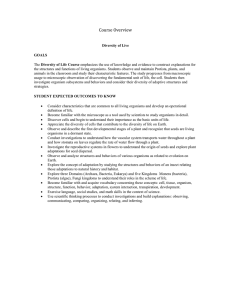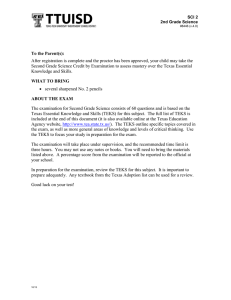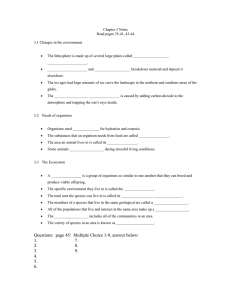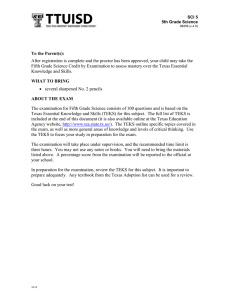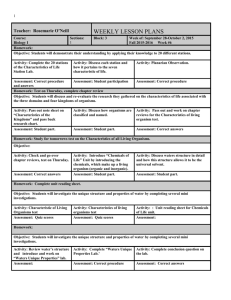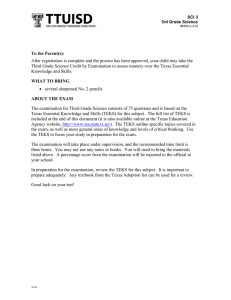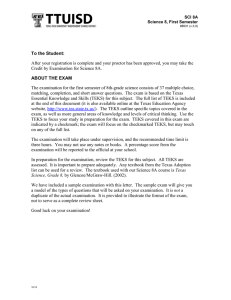After registration is complete and the proctor has been approved,... First Grade Science Credit by Examination to assess mastery over... To the Parent(s):
advertisement
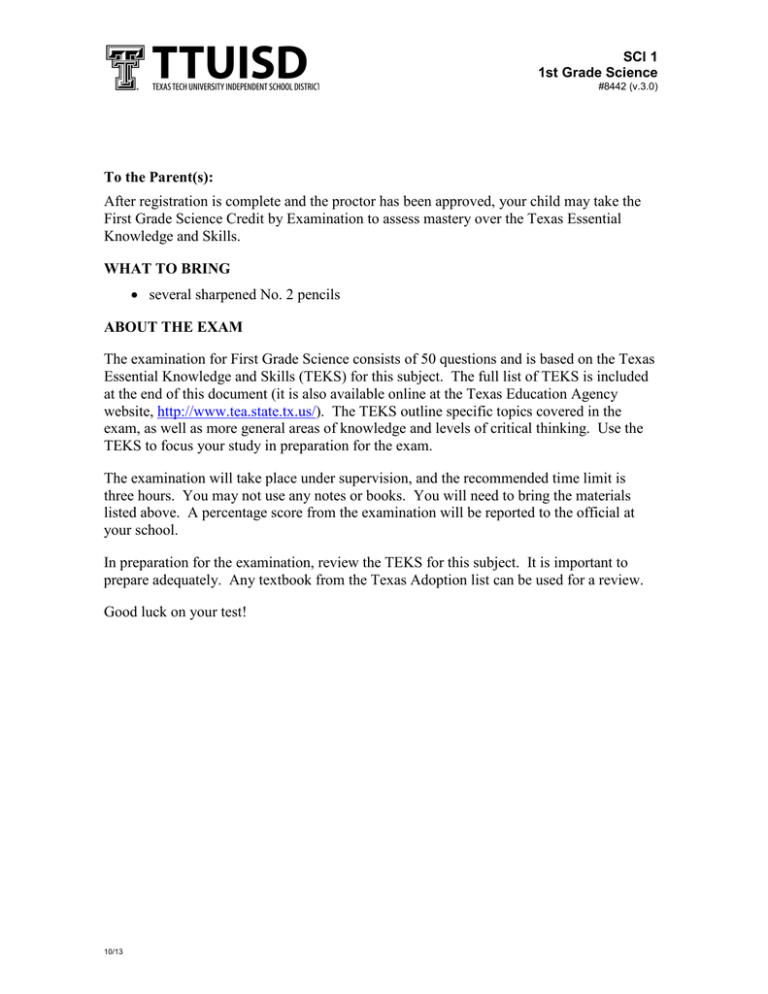
SCI 1 1st Grade Science #8442 (v.3.0) To the Parent(s): After registration is complete and the proctor has been approved, your child may take the First Grade Science Credit by Examination to assess mastery over the Texas Essential Knowledge and Skills. WHAT TO BRING • several sharpened No. 2 pencils ABOUT THE EXAM The examination for First Grade Science consists of 50 questions and is based on the Texas Essential Knowledge and Skills (TEKS) for this subject. The full list of TEKS is included at the end of this document (it is also available online at the Texas Education Agency website, http://www.tea.state.tx.us/). The TEKS outline specific topics covered in the exam, as well as more general areas of knowledge and levels of critical thinking. Use the TEKS to focus your study in preparation for the exam. The examination will take place under supervision, and the recommended time limit is three hours. You may not use any notes or books. You will need to bring the materials listed above. A percentage score from the examination will be reported to the official at your school. In preparation for the examination, review the TEKS for this subject. It is important to prepare adequately. Any textbook from the Texas Adoption list can be used for a review. Good luck on your test! 10/13 Texas Essential Knowledge and Skills SCI 1 – Grade 1 Science §112.3. Science, Grade 1. The provisions of this subchapter shall be implemented by school districts beginning September 1, 1998, and at that time shall supersede §75.28(a)-(f) of this title (relating to Science). (a) Introduction. (1) In Grade 1, the study of science includes simple classroom and field investigations to help students develop the skills of asking questions, gathering information, making measurements using non-standard units, with tools such as a thermometer to extend their senses, constructing explanations, and drawing conclusions. Students also use computers and information technology tools to support their investigations. (2) As students learn science skills, they identify components of the natural world including rocks, soil, and natural resources. Students observe that heat from the Sun or friction, is an example of something that causes change. In addition, students identify basic needs of living things, explore ways that living things depend on each other, and separate living organisms and nonliving things into groups. Students identify parts that can be put together with other parts to do new things. (3) Science is a way of learning about the natural world. Students should know how science has built a vast body of changing and increasing knowledge described by physical, mathematical, and conceptual models, and also should know that science may not answer all questions. (4) A system is a collection of cycles, structures, and processes that interact. Students should understand a whole in terms of its components and how these components relate to each other and to the whole. All systems have basic properties that can be described in terms of space, time, energy, and matter. Change and constancy occur in systems and can be observed and measured as patterns. These patterns help to predict what will happen next and can change over time. (5) Investigations are used to learn about the natural world. Students should understand that certain types of questions can be answered by investigations, and that methods, models, and conclusions built from these investigations change as new observations are made. Models of objects and events are tools for understanding the natural world and can show how systems work. They have limitations and based on new discoveries are constantly being modified to more closely reflect the natural world. (b) Knowledge and skills. (1) Scientific processes. The student conducts classroom and field investigations following home and school safety procedures. The student is expected to: (A) demonstrate safe practices during classroom and field investigations; and (B) learn how to use and conserve resources and materials. (2) Scientific processes. The student develops abilities necessary to do scientific inquiry in the field and the classroom. The student is expected to: (A) ask questions about organisms, objects, and events; (B) plan and conduct simple descriptive investigations; (C) gather information using simple equipment and tools to extend the senses; (D) construct reasonable explanations and draw conclusions; and (E) communicate explanations about investigations. (3) Scientific processes. The student knows that information and critical thinking are used in making decisions. The student is expected to: (A) make decisions using information; (B) discuss and justify the merits of decisions; and (C) explain a problem in his/her own words and identify a task and solution related to the problem. (4) Scientific processes. The student uses age-appropriate tools and models to verify that organisms and objects and parts of organisms and objects can be observed, described, and measured. The student is expected to: (A) collect information using tools including hand lenses, clocks, computers, thermometers, and balances; (B) record and compare collected information; and (C) measure organisms and objects and parts of organisms and objects, using non-standard units such as paper clips, hands, and pencils. (5) Science concepts. The student knows that organisms, objects, and events have properties and patterns. The student is expected to: (A) sort objects and events based on properties and patterns; and (B) identify, predict, and create patterns including those seen in charts, graphs, and numbers. 2 (6) Science concepts. The student knows that systems have parts and are composed of organisms and objects. The student is expected to: (A) sort organisms and objects according to their parts and characteristics; (B) observe and describe the parts of plants and animals; (C) manipulate objects such as toys, vehicles, or construction sets so that the parts are separated from the whole which may result in the part or the whole not working; and (D) identify parts that, when put together, can do things they cannot do by themselves, such as a working camera with film, a car moving with a motor, and an airplane flying with fuel. (7) Science concepts. The student knows that many types of change occur. The student is expected to: (A) observe, measure, and record changes in size, mass, color, position, quantity, sound, and movement; (B) identify and test ways that heat may cause change such as when ice melts; (C) observe and record changes in weather from day to day and over seasons; and (D) observe and record changes in the life cycle of organisms. (8) Science concepts. The student distinguishes between living organisms and nonliving objects. The student is expected to: (A) group living organisms and nonliving objects; and (B) compare living organisms and nonliving objects. (9) Science concepts. The student knows that living organisms have basic needs. The student is expected to: (A) identify characteristics of living organisms that allow their basic needs to be met; and (B) compare and give examples of the ways living organisms depend on each other for their basic needs. (10) Science concepts. The student knows that the natural world includes rocks, soil, and water. The student is expected to: (A) identify and describe a variety of natural sources of water including streams, lakes, and oceans; (B) observe and describe differences in rocks and soil samples; and (C) identify how rocks, soil, and water are used and how they can be recycled. Source: The provisions of this §112.3 adopted to be effective September 1, 1998, 22 TexReg 7647. 3

